A Maturing Church: 1903-1945
In the late 19th century, Milwaukee was at the epicenter of the significant dispute in the U.S. Catholic Church over ethnic issues. German Catholics had built up a strong ethnic identity. So too did the increasing numbers of Polish Catholics, whose parishes opened in the archdiocese’s urban centers. Pressures to change and “Americanize” came not only from some church authorities, but also from the wider society that began to look with concern on the increasing numbers of immigrants arriving from southern and Eastern Europe. Generational issues played a role within ethnic communities, as young people often did not learn the native tongue of their parents or grandparents.
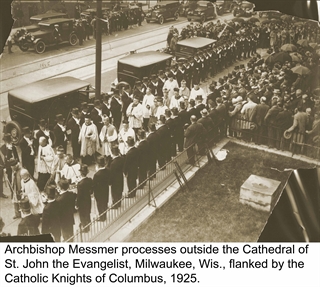 A new archbishop, Sebastian G. Messmer (1847-1930), arrived in 1903. A canon lawyer originally from Switzerland, he had served in the Diocese of Newark, New Jersey at Seton Hall and had impressed bishops by his work at the Third Plenary Council of Baltimore in 1884. In 1891, he was selected the fourth bishop of Green Bay. His eleven-year tenure saw much growth and controversy, especially with Polish Catholics. Despite the controversy, in 1903 he was sent to Milwaukee, which had an even larger Polish population. He remained as archbishop until his death in Switzerland in 1930. He is the only archbishop of Milwaukee not buried there. He was the last of Milwaukee’s foreign-born bishops.
A new archbishop, Sebastian G. Messmer (1847-1930), arrived in 1903. A canon lawyer originally from Switzerland, he had served in the Diocese of Newark, New Jersey at Seton Hall and had impressed bishops by his work at the Third Plenary Council of Baltimore in 1884. In 1891, he was selected the fourth bishop of Green Bay. His eleven-year tenure saw much growth and controversy, especially with Polish Catholics. Despite the controversy, in 1903 he was sent to Milwaukee, which had an even larger Polish population. He remained as archbishop until his death in Switzerland in 1930. He is the only archbishop of Milwaukee not buried there. He was the last of Milwaukee’s foreign-born bishops.
Messmer expanded and upgraded the administrative apparatus of the Archdiocese. In 1908, the archdiocese purchased the old Pabst Mansion on Wisconsin Avenue and transformed the former carriage house into a chancery. It remained the diocesan headquarters until 1975.
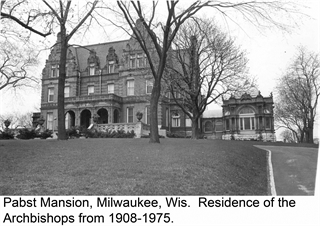 Even though ethnic identity remained strong among many groups, especially the Poles, the archdiocese was using English more and more in its schools and public affairs (including a new diocesan newspaper founded in 1922, the Catholic Herald). Poles had been coming to Milwaukee since the mid-19th century and by the early 20th century had assembled an array of churches, schools, social clubs, and newspapers. Messmer tangled with the Polish clergy over of the building of the huge St. Josaphat Basilica, which was in financial difficulties. The demand of many of the Poles, especially Father Wenceslaus Kruszka (1868-1937), pastor of St. Adalbert’s Parish on Milwaukee’s south side, was for appointment of a Polish-speaking auxiliary bishop to the diocese. Messmer initially balked at this, but in 1911 welcomed a Bohemian-born bishop from Cleveland, Joseph Koudelka (1852-1921), who spoke Polish. However, Koudelka was not acceptable to Milwaukee’s Polish Catholics and was dispatched to the Diocese of Superior in 1913. A Polish-born priest from Michigan, Edward Kozlowski (1860-1915), was chosen in his place and ordained in 1914. He lasted but a year and died. Milwaukee would have no more auxiliaries until 1947.
Even though ethnic identity remained strong among many groups, especially the Poles, the archdiocese was using English more and more in its schools and public affairs (including a new diocesan newspaper founded in 1922, the Catholic Herald). Poles had been coming to Milwaukee since the mid-19th century and by the early 20th century had assembled an array of churches, schools, social clubs, and newspapers. Messmer tangled with the Polish clergy over of the building of the huge St. Josaphat Basilica, which was in financial difficulties. The demand of many of the Poles, especially Father Wenceslaus Kruszka (1868-1937), pastor of St. Adalbert’s Parish on Milwaukee’s south side, was for appointment of a Polish-speaking auxiliary bishop to the diocese. Messmer initially balked at this, but in 1911 welcomed a Bohemian-born bishop from Cleveland, Joseph Koudelka (1852-1921), who spoke Polish. However, Koudelka was not acceptable to Milwaukee’s Polish Catholics and was dispatched to the Diocese of Superior in 1913. A Polish-born priest from Michigan, Edward Kozlowski (1860-1915), was chosen in his place and ordained in 1914. He lasted but a year and died. Milwaukee would have no more auxiliaries until 1947.
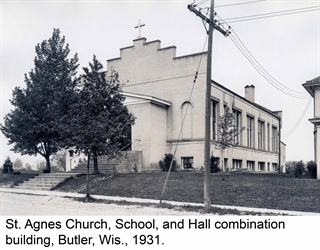 Under Messmer, church building boomed in nearly every city of the archdiocese. New parishes cropped up in every direction in Milwaukee, especially in the industrial suburbs of West Allis and Cudahy, and also in communities like Racine and Kenosha. Accommodating the still growing Polish population was critical. Among the new migrants to the archdiocese were African Americans who grew in numbers in Milwaukee. At the urging of African American layman Lincoln Valle and his wife Julia, the archdiocese opened a mission for black Catholics. This small mission, named for St. Benedict the Moor, was eventually moved to 10th and State streets near the Marquette Academy. The Capuchin Fathers assumed ministerial responsibility for the work begun by the Valles. The mission eventually established a boarding and day school, a highly successful high school, and a church. It welcomed scores of African American converts to the Catholic Church every year. Working alongside the Capuchins in this ministry were the School Sisters of Notre Dame and later the Racine Dominicans. More details are available here.
Under Messmer, church building boomed in nearly every city of the archdiocese. New parishes cropped up in every direction in Milwaukee, especially in the industrial suburbs of West Allis and Cudahy, and also in communities like Racine and Kenosha. Accommodating the still growing Polish population was critical. Among the new migrants to the archdiocese were African Americans who grew in numbers in Milwaukee. At the urging of African American layman Lincoln Valle and his wife Julia, the archdiocese opened a mission for black Catholics. This small mission, named for St. Benedict the Moor, was eventually moved to 10th and State streets near the Marquette Academy. The Capuchin Fathers assumed ministerial responsibility for the work begun by the Valles. The mission eventually established a boarding and day school, a highly successful high school, and a church. It welcomed scores of African American converts to the Catholic Church every year. Working alongside the Capuchins in this ministry were the School Sisters of Notre Dame and later the Racine Dominicans. More details are available here.

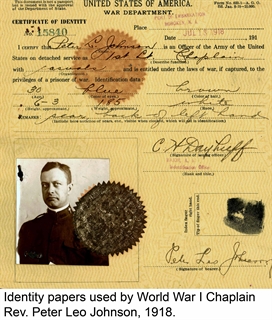 World War I deeply affected the Catholics of the archdiocese, many of whom came from the warring countries abroad. German and Austrian Catholics were at first in favor of the Central Powers and lamented the death of Austrian Emperor Franz Josef in a Mass at St. John’s Cathedral. Later, when the United States went to war against Germany, German Catholics loyally supported the American cause and enlisted. Polish Catholics rejoiced in the rebirth of their homeland in 1918. A number of Milwaukee priests signed up for chaplain duty, including Father Peter Leo Johnson, Father John J. Shanahan, and Father George Eilers.
World War I deeply affected the Catholics of the archdiocese, many of whom came from the warring countries abroad. German and Austrian Catholics were at first in favor of the Central Powers and lamented the death of Austrian Emperor Franz Josef in a Mass at St. John’s Cathedral. Later, when the United States went to war against Germany, German Catholics loyally supported the American cause and enlisted. Polish Catholics rejoiced in the rebirth of their homeland in 1918. A number of Milwaukee priests signed up for chaplain duty, including Father Peter Leo Johnson, Father John J. Shanahan, and Father George Eilers.
Post-World War I prosperity increased Catholic numbers and parochial expansion. St. Francis Seminary underwent significant changes in its curriculum and faculty, in part due to demands of Roman authorities and the emergence of the 1918 Code of Canon Law. Roman models for clerical life, including a distinctive garb and uniform theological education became mandatory during this time.
Archbishop Messmer was ill often during the 1920s, spending long periods in a Louisiana sanitarium, leaving the day-to-day affairs in the hands of his Vicar General, Monsignor Bernard Traudt. Messmer died unexpectedly in August 1930 while vacationing in his native Switzerland. The Holy See then appointed the youthful Samuel Alphonsus Stritch (1887-1958) as archbishop. Stritch was a native of Nashville, Tennessee, serving as bishop of Toledo, Ohio at the time of his appointment to Milwaukee.
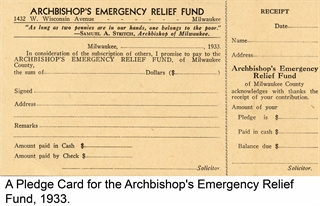 Stritch arrived in 1930, just as the Great Depression was descending on southeastern Wisconsin and creating significant economic dislocations. The archdiocese’s slender finances were stressed during this time. Stritch was cautious in expending archdiocesan funds. He turned down efforts to relocate the major seminary to a more remote area. When the Cathedral of St. John burned in 1935, he held off as long as he could before rebuilding it. It finally reopened in 1942. To handle the demand on charities, Stritch inaugurated an “emergency” appeal that found a generous response. This appeal today is known as the Catholic Stewardship Appeal, a major source of funding for archdiocesan projects.
Stritch arrived in 1930, just as the Great Depression was descending on southeastern Wisconsin and creating significant economic dislocations. The archdiocese’s slender finances were stressed during this time. Stritch was cautious in expending archdiocesan funds. He turned down efforts to relocate the major seminary to a more remote area. When the Cathedral of St. John burned in 1935, he held off as long as he could before rebuilding it. It finally reopened in 1942. To handle the demand on charities, Stritch inaugurated an “emergency” appeal that found a generous response. This appeal today is known as the Catholic Stewardship Appeal, a major source of funding for archdiocesan projects.
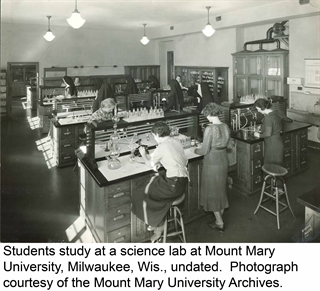 Stritch was interested in education. The archdiocese had already begun to standardize its schools under a common superintendent, with uniformity in instruction, textbooks, and calendar. This continued under Stritch, who sent Father (later monsignor) Edmund Goebel (1895-1973) for advanced studies in education. Stritch later appointed Goebel superintendent of Catholic schools. Goebel, working together with religious women’s communities, sought to further upgrade and expand Catholic education.
Stritch was interested in education. The archdiocese had already begun to standardize its schools under a common superintendent, with uniformity in instruction, textbooks, and calendar. This continued under Stritch, who sent Father (later monsignor) Edmund Goebel (1895-1973) for advanced studies in education. Stritch later appointed Goebel superintendent of Catholic schools. Goebel, working together with religious women’s communities, sought to further upgrade and expand Catholic education.
 In 1929, the archdiocese opened a free-standing, four-year, coed high school, named “Messmer High.” Supporting the school was always challenging, but the school, administered by the School Sisters of Notre Dame, became one of the leading educational institutions in the archdiocese.
In 1929, the archdiocese opened a free-standing, four-year, coed high school, named “Messmer High.” Supporting the school was always challenging, but the school, administered by the School Sisters of Notre Dame, became one of the leading educational institutions in the archdiocese.
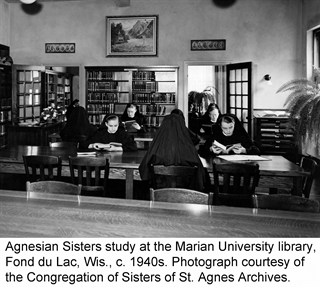 Stritch urged the sisters to upgrade the quality of their teacher preparation. In response several communities, including the Sisters of St. Francis on Lake Drive, the School Sisters of St. Francis, the Racine Dominicans, and the Sisters of St. Agnes in Fond du Lac developed weekend and summer educational programs for their sisters that allowed them to make progress toward a degree. These programs all evolved into free-standing colleges. The sisters also came to specialize in the teaching of music.
Stritch urged the sisters to upgrade the quality of their teacher preparation. In response several communities, including the Sisters of St. Francis on Lake Drive, the School Sisters of St. Francis, the Racine Dominicans, and the Sisters of St. Agnes in Fond du Lac developed weekend and summer educational programs for their sisters that allowed them to make progress toward a degree. These programs all evolved into free-standing colleges. The sisters also came to specialize in the teaching of music.
The Depression era also saw a flourishing of lay activity under the auspices of Catholic Action. Messmer had unified Catholic Action movements. Stritch appointed Father Paul Tanner as the director of Catholic Action, and lay groups like the Holy Name Society under Leo Dohan and the Milwaukee Archdiocesan Council of Catholic Women under attorney Katherine Williams flourished and did much for the local church. The Catholic Instruction League, later to be succeeded by the Confraternity of Christian Doctrine, advanced educating public school children in the tenets of the faith. Catholic book publishing also found a home in Milwaukee under the imprint of Bruce Publishing. William George Bruce, the patriarch of the family, was a citizen of great distinction. He handed down the press he started to his sons, who transformed it into one of the largest Catholic publishing houses in the United States.
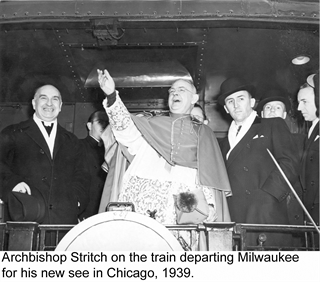 Stritch was a popular bishop. Easily approachable, he frequently took long walks down Wisconsin Avenue. He loved to preach and preside at parish celebrations. He was also prone to fits of depression, during which he would isolate himself in his room. His faithful secretary, Father Roman Atkielski, could coax him out. To the surprise of Milwaukee Catholics, Archbishop Stritch was transferred to the Archdiocese of Chicago in 1940. In his place came Moses Elias Kiley (1876-1953), the bishop of Trenton, New Jersey.
Stritch was a popular bishop. Easily approachable, he frequently took long walks down Wisconsin Avenue. He loved to preach and preside at parish celebrations. He was also prone to fits of depression, during which he would isolate himself in his room. His faithful secretary, Father Roman Atkielski, could coax him out. To the surprise of Milwaukee Catholics, Archbishop Stritch was transferred to the Archdiocese of Chicago in 1940. In his place came Moses Elias Kiley (1876-1953), the bishop of Trenton, New Jersey.
Kiley, tall and sepulchral of voice, was born in 1876 in Nova Scotia. He had served as a motorman in Boston before discovering a vocation to the priesthood. He was ordained for the Archdiocese of Chicago and ran a shelter for down-and-out men. In the 1920s, Archbishop Mundelein sent Kiley to the North American College in Rome to become a spiritual director. He also was the guest priest for visiting U.S. dignitaries.
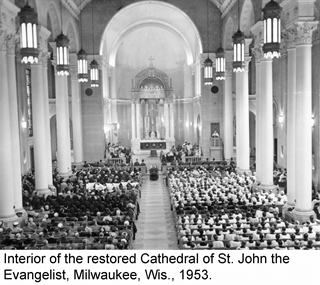 In 1934 Kiley was consecrated a bishop and sent to Trenton, which was having severe financial difficulties. He managed to pull the diocese back from the brink. In 1940, he was enthroned as Milwaukee’s sixth archbishop in Gesu Church (the cathedral was still in ruins.) Kiley was an effective administrator. He pushed forward the plans for rebuilding the cathedral, creating a basilica style church, constructing an elaborate cupola over the altar and installing rondels over the new windows with the images of his predecessors. Kiley also began to raise funds to replace the destroyed St. Aemillian’s Orphanage, which had burned in in the 1930s. Kiley spearheaded a major reorganization of the seminary, moving the high school and junior college programs from the seminary to nearby Pio Nono High school (today St. Thomas More High School). He was passionately devoted to the Sacred Heart and promoted the devotion throughout the archdiocese. Kiley was a hard and sometime fearsome prelate, quite unlike his affable predecessor. His deep voice could sometimes be heard yelling at some hapless cleric who had offended him. His health deteriorated steadily in the 1950s and he died at St. Mary’s Hospital on April 15, 1953.
In 1934 Kiley was consecrated a bishop and sent to Trenton, which was having severe financial difficulties. He managed to pull the diocese back from the brink. In 1940, he was enthroned as Milwaukee’s sixth archbishop in Gesu Church (the cathedral was still in ruins.) Kiley was an effective administrator. He pushed forward the plans for rebuilding the cathedral, creating a basilica style church, constructing an elaborate cupola over the altar and installing rondels over the new windows with the images of his predecessors. Kiley also began to raise funds to replace the destroyed St. Aemillian’s Orphanage, which had burned in in the 1930s. Kiley spearheaded a major reorganization of the seminary, moving the high school and junior college programs from the seminary to nearby Pio Nono High school (today St. Thomas More High School). He was passionately devoted to the Sacred Heart and promoted the devotion throughout the archdiocese. Kiley was a hard and sometime fearsome prelate, quite unlike his affable predecessor. His deep voice could sometimes be heard yelling at some hapless cleric who had offended him. His health deteriorated steadily in the 1950s and he died at St. Mary’s Hospital on April 15, 1953.
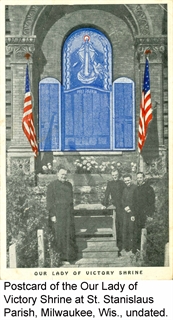 The United States entered World War II in1941. Thousands of Wisconsin men entered the armed forces to fight in Europe and the Pacif. A number of Milwaukee priests volunteered for service including Raymond Vint, David Ryan, Harold Prudell, and Mathias Zerfas. Zerfas was captured at Bataan in the Philippines and died when his prison ship was attacked by American aircraft. On the home front, Catholics actively participated in the war effort, sending clothing, bandages, and scrap, and purchasing war bonds and stamps. Catholic children put together packages for chaplains, offered prayers for the safe return of loved ones, and participated at sad Requiem Masses over the remains of those who fell in battle. One Milwaukee priest, Father Raymond Punda, composed a set of popular novena prayers to “Our Lady of Victory.” Notre Dame Sister Roman Obremski painted a patriot mural of her for an outdoor shrine at St. Stanislaus Church, Milwaukee.
The United States entered World War II in1941. Thousands of Wisconsin men entered the armed forces to fight in Europe and the Pacif. A number of Milwaukee priests volunteered for service including Raymond Vint, David Ryan, Harold Prudell, and Mathias Zerfas. Zerfas was captured at Bataan in the Philippines and died when his prison ship was attacked by American aircraft. On the home front, Catholics actively participated in the war effort, sending clothing, bandages, and scrap, and purchasing war bonds and stamps. Catholic children put together packages for chaplains, offered prayers for the safe return of loved ones, and participated at sad Requiem Masses over the remains of those who fell in battle. One Milwaukee priest, Father Raymond Punda, composed a set of popular novena prayers to “Our Lady of Victory.” Notre Dame Sister Roman Obremski painted a patriot mural of her for an outdoor shrine at St. Stanislaus Church, Milwaukee.
By: Rev. Steven M. Avella
Photographs and documents courtesy of the Archdiocese of Milwaukee Archives, unless otherwise noted. Photographs and documents cannot be reproduced without prior written authorization. For permission to reproduce contact the archdiocesan archives.